Related Research Articles
The Kingsmill massacre was a mass shooting that took place on 5 January 1976 near the village of Whitecross in south County Armagh, Northern Ireland. Gunmen stopped a minibus carrying eleven Protestant workmen, lined them up alongside it and shot them. Only one victim survived, despite having been shot 18 times. A Catholic man on the minibus was allowed to go free. A group calling itself the South Armagh Republican Action Force claimed responsibility. It said the shooting was retaliation for a string of attacks on Catholic civilians in the area by Loyalists, particularly the killing of six Catholics the night before. The Kingsmill massacre was the climax of a string of tit-for-tat killings in the area during the mid-1970s, and was one of the deadliest mass shootings of the Troubles.
The Troubles in Lurgan recounts incidents during the Troubles in Lurgan, County Armagh, Northern Ireland.
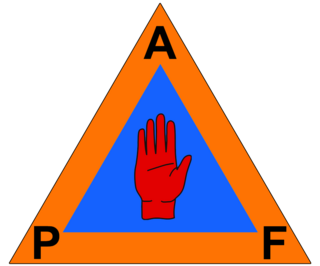
The Protestant Action Force (PAF) was a cover name used by Ulster loyalist paramilitary group the Ulster Volunteer Force (UVF) when claiming responsibility for a number of attacks during the Troubles in Northern Ireland. Sometimes these actions were carried out with the assistance of members of the security forces. The name "PAF" was first used in 1974 and attacks by individuals claiming to be members of the PAF killed at least 41 Catholic civilians. All of the attacks claimed by the PAF in Armagh and Tyrone counties from 1974 to 1976 have been linked to the Glenanne gang, which was a loose coalition consisting of members of the UVF Mid-Ulster Brigade along with rogue Ulster Defence Regiment (UDR) soldiers and Royal Ulster Constabulary (RUC) police officers. A six-year period of no attacks claimed by the PAF ended in 1982; during the 1980s, the PAF claimed 15 attacks in the Belfast area and two in County Armagh. UDR soldiers were convicted of two attacks in Armagh. The PAF claimed its last attacks in the early 1990s, all of which were in north Armagh and were alleged to involve members of the security forces.
The Reavey and O'Dowd killings were two coordinated gun attacks on 4 January 1976 in County Armagh, Northern Ireland. Six Catholic civilians died after members of the Ulster Volunteer Force (UVF), an Ulster loyalist paramilitary group, broke into their homes and shot them. Three members of the Reavey family were shot at their home in Whitecross and four members of the O'Dowd family were shot at their home in Ballydougan. Two of the Reaveys and three of the O'Dowds were killed outright, with the third Reavey victim dying of brain haemorrhage almost a month later.
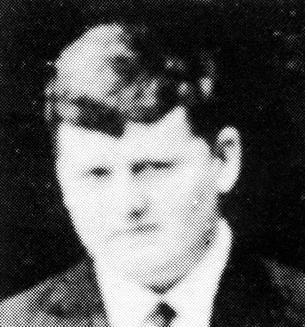
John Francis Green, was a leading member of the North Armagh Brigade of the Provisional Irish Republican Army. He was killed in a farmhouse outside Castleblayney, County Monaghan, by members of the Mid-Ulster Brigade of the Ulster Volunteer Force (UVF). According to Fred Holroyd, Special Reconnaissance Unit officer Robert Nairac was involved in Green's killing. Green's was one of the 87 killings attributed by the Pat Finucane Centre to the group of Ulster loyalist paramilitaries, Ulster Defence Regiment soldiers and Royal Ulster Constabulary officers known as the Glenanne gang. No one was ever prosecuted for the killing.
This is a timeline of actions by the Ulster Volunteer Force (UVF), an Ulster loyalist paramilitary group since 1966. It includes actions carried out by the Red Hand Commando (RHC), a group integrated into the UVF shortly after their formation in 1972. It also includes attacks claimed by the Protestant Action Force (PAF), a covername used by the UVF. Most of these actions took place during the conflict known as "the Troubles" in Northern Ireland.

The Glenanne gang or Glenanne group was a secret informal alliance of Ulster loyalists who carried out shooting and bombing attacks against Catholics and Irish nationalists in the 1970s, during the Troubles. Most of its attacks took place in the "murder triangle" area of counties Armagh and Tyrone in Northern Ireland. It also launched some attacks elsewhere in Northern Ireland and in the Republic of Ireland. The gang consisted of soldiers from the British Army's Ulster Defence Regiment (UDR), police officers from the Royal Ulster Constabulary (RUC), and members of the Mid-Ulster Brigade of the Ulster Volunteer Force (UVF). Twenty-five UDR soldiers and RUC police officers were named as purported members of the gang. Details about the group have come from many sources, including the affidavit of former member and RUC officer John Weir; statements by other former members; police, army and court documents; and ballistics evidence linking the same weapons to various attacks. Since 2003, the group's activities have also been investigated by the 2006 Cassel Report, and three reports commissioned by Irish Supreme Court Justice Henry Barron, known as the Barron Reports. A book focusing on the group's activities, Lethal Allies: British Collusion in Ireland, by Anne Cadwallader, was published in 2013. It drew on all the aforementioned sources, as well as Historical Enquiries Team investigations. The book was the basis for the 2019 documentary film Unquiet Graves, directed by Sean Murray.
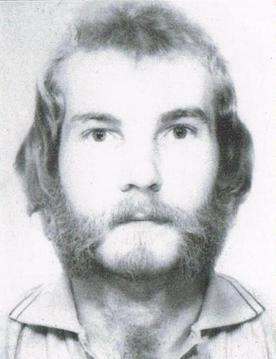
Harris Boyle was an Ulster Defence Regiment (UDR) soldier and a high-ranking member of the Ulster Volunteer Force (UVF), a Northern Irish loyalist paramilitary organisation. Boyle was implicated in the 1974 Dublin and Monaghan bombings, and took part in the attack at Buskhill, County Down when an armed UVF gang wearing British Army uniforms ambushed The Miami Showband at a bogus military checkpoint. The popular Irish cabaret band was driving home to Dublin after a performance in Banbridge. He was one of the two gunmen killed when the bomb they were loading onto the band's minibus exploded prematurely. He is sometimes referred to as Horace Boyle.
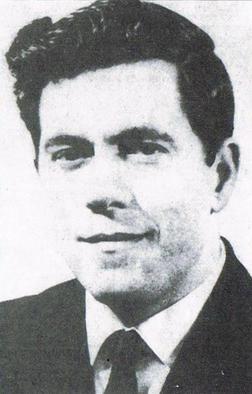
Robert William McConnell, was an Ulster loyalist paramilitary who allegedly carried out or was an accomplice to a number of sectarian attacks and killings, although he never faced any charges or convictions. McConnell served part-time as a corporal in the 2nd Battalion Ulster Defence Regiment (UDR), and was a suspected member of the Ulster Volunteer Force (UVF).

The Tullyvallen massacre took place on 1 September 1975, when Irish republican gunmen attacked an Orange Order meeting hall at Tullyvallen, near Newtownhamilton in County Armagh, Northern Ireland. The Orange Order is an Ulster Protestant and unionist brotherhood. Five Orangemen were killed and seven wounded in the shooting. The "South Armagh Republican Action Force" claimed responsibility, saying it was retaliation for a string of attacks on Catholic civilians by Loyalists. It is believed members of the Provisional IRA carried out the attack, despite the organisation being on ceasefire.
John Oliver Weir is an Ulster loyalist born and raised in the Republic of Ireland. He served as an officer in Northern Ireland's Royal Ulster Constabulary's (RUC) Special Patrol Group (SPG), and was a volunteer in the illegal Ulster Volunteer Force (UVF). As a member of the UVF's Mid-Ulster Brigade led by Robin "the Jackal" Jackson, Weir was a part of the Glenanne gang, a group of loyalist extremists that carried out sectarian attacks mainly in the County Armagh area in the mid-1970s.
UVF Mid-Ulster Brigade formed part of the loyalist paramilitary Ulster Volunteer Force in Northern Ireland. The brigade was established in Lurgan, County Armagh in 1972 by its first commander Billy Hanna. The unit operated mainly around the Lurgan and Portadown areas. Subsequent leaders of the brigade were Robin Jackson, known as "The Jackal", and Billy Wright. The Mid-Ulster Brigade carried out many attacks, mainly in Northern Ireland, especially in the South Armagh area, but it also extended its operational reach into the Republic of Ireland. Two of the most notorious attacks in the history of the Troubles were carried out by the Mid-Ulster Brigade: the 1974 Dublin and Monaghan bombings and the Miami Showband killings in 1975. Members of the Mid-Ulster Brigade were part of the Glenanne gang which the Pat Finucane Centre has since linked to at least 87 lethal attacks in the 1970s.
The 1991 Cappagh killings was a gun attack by the loyalist Ulster Volunteer Force (UVF) on 3 March 1991 in the village of Cappagh, County Tyrone, Northern Ireland. A unit of the UVF's Mid-Ulster Brigade drove to the staunchly republican village and shot dead three Provisional IRA members and a Catholic civilian at Boyle's Bar.

The Hillcrest Bar bombing, also known as the "Saint Patrick's Day bombing", took place on 17 March 1976 in Dungannon, County Tyrone, Northern Ireland. The Ulster Volunteer Force (UVF), a loyalist paramilitary group, detonated a car bomb outside a pub crowded with people celebrating Saint Patrick's Day. Four Catholic civilians were killed by the blast—including two 13-year-old boys standing outside—and almost 50 people were injured, some severely.
On 2 October 1975, the loyalist paramilitary group the Ulster Volunteer Force (UVF) carried out a wave of shootings and bombings across Northern Ireland. Six of the attacks left 12 people dead and around 45 people injured. There was also an attack in a small village in County Down called Killyleagh. There were five attacks in and around Belfast which left people dead. A bomb which exploded in Coleraine left four UVF members dead. There were also several other smaller bombs planted around Northern Ireland but other than causing damage they did not kill or injure anyone.
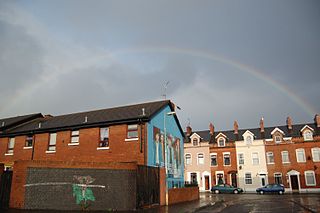
In the late hours of 3 February and the early hours of 4 February 1973, six men, all of whom were Catholics, were shot and killed in the New Lodge area of north Belfast:

On 14 November 1991 the Ulster Volunteer Force (UVF), a loyalist paramilitary group, shot dead three civilians in Craigavon, County Armagh, Northern Ireland. The three men were driving home from work at the Hyster forklift factory.
The Charlemont pub attacks were co-ordinated militant Loyalist paramilitary attacks on two pubs in the small village of Charlemont, County Armagh, Northern Ireland, carried out by the Ulster Volunteer Force (UVF) on 15 May 1976. The attacks have been attributed to the Glenanne gang which was a coalition of right-wing Loyalist paramilitaries and subversive members inside the Royal Ulster Constabulary (RUC), the Ulster Defense Regiment (UDR) and the British Army.
A pub bombing or a public house bombing is an attack on a pub or public house using explosives and other bombing making material like nails, bolts, screws and similar objects which can cause horrific injuries when the bomb detonates. The Provisional IRA's Balcombe Street Gang used bolts and screws in many of their bomb attacks in the mid-1970s. Neo-nazi David Copeland used nails in his bombs.

The Stag Inn attack was a sectarian gun attack, on 30 July 1976, carried out by a group of Belfast IRA Volunteers using the cover name Republican Action Force. Four Protestants, all civilians, the youngest being 48 years old and the eldest 70, were all killed in the attack with several others being injured. Three Catholics were killed the previous day in a Loyalist bomb attack, part of a string of sectarian attacks in Northern Ireland by different paramilitary organizations.
References
- 1 2 McKittrick, David. Lost Lives: The Stories of the Men, Women and Children who Died as a Result of the Northern Ireland Troubles. Random House, 2001. p.537
- 1 2 3 4 5 Cadwallader 2013, p. 95.
- ↑ "CAIN: Chronology of the Conflict 1975". cain.ulster.ac.uk. Retrieved 29 June 2020.
- ↑ "CAIN: Sutton Index of Deaths". cain.ulster.ac.uk. Retrieved 29 June 2020.
- ↑ Cadwallader 2013, p. 13, 95.
- ↑ "CAIN: Sutton Index of Deaths". cain.ulster.ac.uk. Retrieved 27 June 2020.
- ↑ Cadwallader 2013, p. 13, 87-90.
- 1 2 3 Report of the Independent International Panel on Alleged Collusion on Sectarian Killings in Northern Ireland Archived 20 February 2015 at the Wayback Machine . Center for Civil and Human Rights, Notre Dame Law School, 2006. p. 47
- ↑ Cadwallader 2013, p. 12, 55.